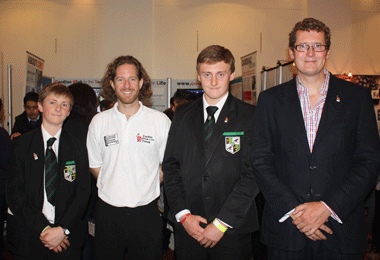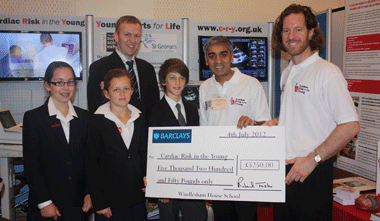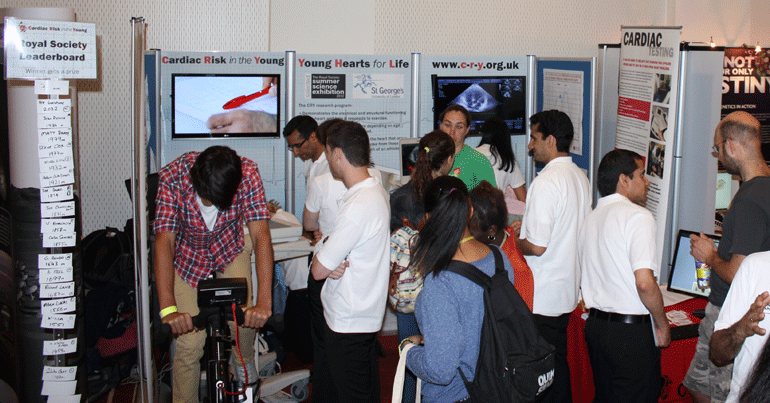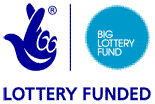 6 days, 2 press briefings, over 10,000 visitors, over 200 blog posts, more than 300 ECGs performed, around 1 million miles clocked up on the CRY exercise bike (Wattbike), 20 team members working round the clock, 6 CRY Research Fellows, 1 Professor….all adds up to one amazing week for CRY at the Royal Society’s Summer Exhibition 2012.
6 days, 2 press briefings, over 10,000 visitors, over 200 blog posts, more than 300 ECGs performed, around 1 million miles clocked up on the CRY exercise bike (Wattbike), 20 team members working round the clock, 6 CRY Research Fellows, 1 Professor….all adds up to one amazing week for CRY at the Royal Society’s Summer Exhibition 2012.
During this exciting Olympic year, the team at CRY – led by Director of Screening, Dr Steve Cox and consultant cardiologist, Professor Sanjay Sharma – were delighted to be selected as one of twenty exhibitors at the world famous Royal Society Summer Science Exhibition. The Royal Society is a Fellowship of the world’s most eminent scientists and is the oldest scientific academy in continuous existence.
The Summer Science Exhibition is the Society’s main public event of the year and is open to members of the general public as well as students and teachers, scientists, policymakers and the media. This prestigious exhibition showcases the most exciting cutting-edge science and technology research. It provides a unique opportunity for members of the public to interact with scientists and ask them questions about their work. It was therefore a great chance for the CRY team to meet and greet a huge and varied audience across a period of six days and to communicate the charity’s key messages to thousands of interested and enthusiastic young people.
For several months leading up to the event opening, Dr Steve Cox worked alongside Professor Sharma and the press teams from both CRY and the Royal Society to agree on CRY’s key messages from the research; the format of the stand; and to develop a strong media story.

Due to the current huge amount of interest in sports medicine and the effects of exercise on the heart, CRY was also selected as one of just four exhibitors who would enjoy a higher profile at the Exhibition and who would also be invited to present at an exclusive national press conference a few days before the official opening.
The research that Professor Sharma and CRY presented was entitled: “The Athlete’s Heart – Young Hearts for Life”. The research explored the structural and electrical functioning of the heart and how it responds to exercise.
It also looked at the importance of experts understanding the fundamental differences between a ‘normal’ heart and an athlete’s heart; and taking on board appropriate considerations when individuals are being screened.
More about the CRY exhibit on The Royal Society website
Over the weekend leading up to the Exhibition – which included a supportive Tweet from comedian Eddie Izzard! – Dr Steve Cox and the CRY team worked round the clock to build an innovative and interactive exhibition stand to attract the crowds.
The CRY exhibit comprised two areas where ECGs could be taken and hand-held demos with the Echocardiogram (ultrasound) probe could take place; a static exercise bike (Wattbike) for the latest incarnation of the CRY ‘Cyclathon’ challenge; stacks of CRY information and leaflets for visitors; a functioning model of the heart and circulatory system; big screens where the new videos with Olympic hopeful and CRY Patron, Lawrence Okoye, were broadcast; and a social media hub, for a continuous live stream of blog posts and Tweets direct from the Exhibition. (see the Exhibit blog)
During the second press preview day on Monday 2nd July, the exhibit was visited by Claudia Hammond from BBC World Service. She recorded a three minute news programme, featuring her taking part in a full cardiac screening!
Listen to the BBC World Service programme
Dr Steve Cox, Professor Sharma and the six CRY Research Fellows led the way in speaking to and educating the many thousands of people who visited the CRY exhibit across the week.
The first visitors started coming through the doors at 10am, with the last ones often not leaving until 9pm. On two consecutive nights, the CRY team also welcomed special guests to the stand during the Society’s evening ‘soirees’, as VIPs and distinguished fellows from the Royal Society took part in a tour of the 20 stands. This was a particular highlight of the week, as it gave the CRY team the opportunity to discuss their research with some of the most eminent researchers in the world.
Perhaps the most talked about part of the CRY exhibit was the ‘Cyclathon Challenge’ where visitors – ensuring they were well hydrated first! – were invited to hop on an exercise bike and see how many metres they could clock up in 3 minutes. This was to help demonstrate the effect of exercise on the heart and many of the participants were encouraged to have an immediate look at how their own heart was ‘behaving’ after such strenuous exercise, using the Echo probe.
As part of the challenge, there was competition to see which visitors could cycle the furthest in 3 minutes – with so many enthusiastic teenagers at the event, the competition was fierce! The top female cyclist at the end of the event was Kirsten Lillie who travelled 1932 metres; and the top male cyclist was Neil Thompson who travelled 2188 metres. Both win a CRY goody bag for their efforts – congratulations to them; and CRY would like to thank everyone who took a turn on the bike!
Amongst the many visitors who came to the CRY exhibit over the week was CRY Patron and football legend, Pat Jennings, who came along on Tuesday 3rd July with his grandson Niall. Pat talked to Professor Sharma and the CRY Research Fellows about various aspects of the exhibit and Niall had a look at his own heart with the Echo probe.

As well as the constant stream of visitors coming to the CRY exhibit, a number of families and schools – who now work closely with CRY having been affected by young sudden cardiac death – were specifically invited to attend the stand.
Photo calls for these visits took place ‘in situ’ with these images being immediately blogged, Tweeted, posted on CRY’s Facebook page and sent out to the relevant local media.
A number of pupils from Ravens Wood School in Kent attended the exhibit, and Deputy Head James Frost said:
“It was a great opportunity for us to be able to bring along a group of boys to such a high profile exhibition and to be able to interact, first hand, with such world leading scientists and researchers.
“The boys also enjoyed engaging with the team from CRY – a charity we have a close affiliation with since the sudden death of one of our pupils, Ben [Daniels], last year.”

Three pupils from Windlesham House School, West Sussex – Abigail Aiken, Jasmine Seager and Jamie Sharpe (pictured left) – were also invited to the CRY exhibit. Head of Design and Technology at the school, Stuart Edwards (also pictured) said:
“We were very pleased to have the opportunity to bring along three of our pupils – who had already been involved in raising awareness for CRY – to such a high profile exhibition.
“We all enjoyed meeting the team from CRY – a charity we have a close affiliation with since the sudden death of one of our ex- pupils, Max Lowry.
“We were also delighted to present a cheque for over £5,000 to CRY’s Deputy Chief Executive, Dr Steve Cox.”
A number of CRY supporters volunteered to help out at the exhibit and were invaluable in assisting the CRY team over the course of the week. Special thanks to CRY Representatives Carl and Eunice Johnson (who lost their daughter Lisa to SADS in December 2006, aged 30); and CRY Representative Julie Donnelly (whose 17 year old son Adam died suddenly in July 2004 from an undiagnosed heart condition) – who also presented CRY with a cheque for over £20,000!
Special thanks as well to Julie Donnelly’s daughter (Adam’s sister), Sian Donnelly. Sian has been diagnosed with the condition Brugada syndrome and took part in a demonstration whereby Professor Sharma could show on the Echocardiogram the differences between a ‘normal’ heart and the heart of someone with Brugada syndrome.
Overall, CRY’s exhibit at The Royal Society Summer Science Exhibition has been hailed by all as a huge success! It was the brainchild of Dr Steve Cox, who had this to say about CRY’s week in the heart of London’s most distinguished scientific community:
“The event was incredible. One minute our doctors were explaining to children how the heart works, the next we would be discussing our research with the most highly respected academics in the world. What a fantastic opportunity to talk about our research and the incredible progress we have made since 1995 in bringing to the forefront the important issues of cardiac conditions in young people.
“It was hard work, it was exhausting but it was worth all the effort; and I, and the whole team, enjoyed every minute. I couldn’t have done it without Professor Sanjay Sharma and his team of amazing CRY Research Fellows; not to mention the dedication of CRY staff and our wonderful volunteers.”
He added; “The dynamic mix of world leading research, hands-on understanding of the human heart and a rolling social media campaign, meant that CRY was able to constantly communicate with a wide and captive audience of both health professionals and the public. It really was a once-in-a-lifetime opportunity for the charity. Although, who knows, maybe we’ll apply to do it again one day…!”
See more photos at the Exhibit blog

The research is overseen by Professor Sanjay Sharma – Professor of Inherited Cardiac Diseases and Sports Cardiology at St George’s; and CRY’s consultant cardiologist.
The Summer Science Exhibition was part funded by the National Lottery through the Big Lottery Fund.







